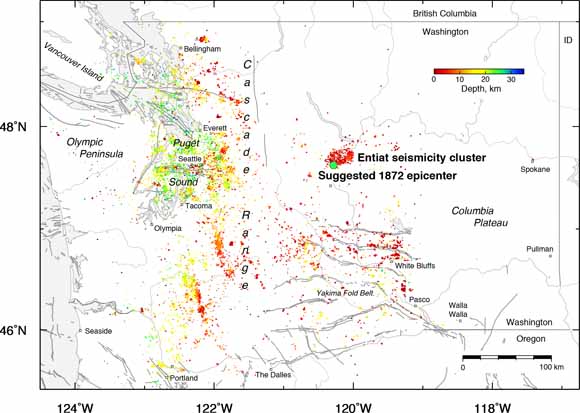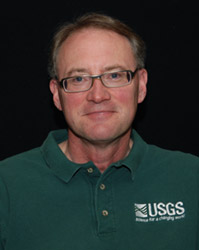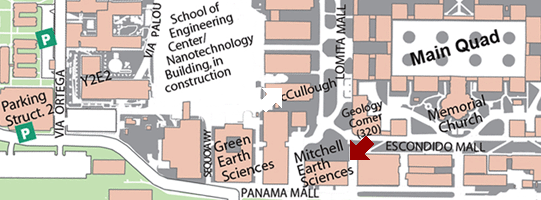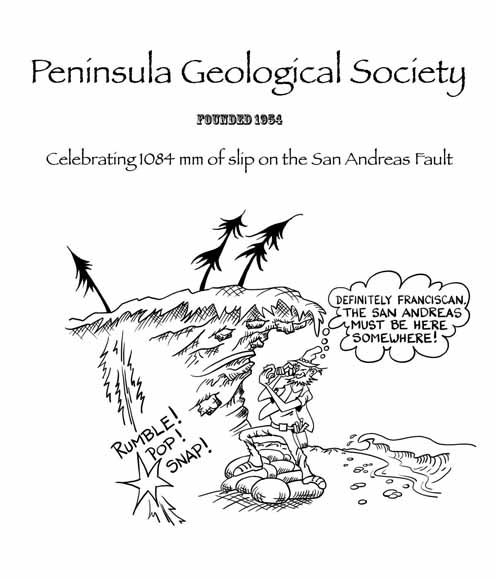
Presents
Location: Stanford University
Anyone wishing to attend the lecture only is welcome at no cost.
This will be the 466th meeting since 1954

Omori’s law and rate-and-state models predict that aftershocks may persist for hundreds or even thousands of years in regions having low deformation rates. Perhaps the best-documented example of a long-lived aftershock sequence resulted from the Mw 7.5 1891 Nobi earthquake in Japan, where aftershocks persisted for more than 100 years. In this talk, I present evidence for another long-lived aftershock sequence, located in central Washington state, USA. In this location, there is a well-defined ongoing and prolific seismicity cluster, near Entiat, located in the epicentral area of the December 14, 1872 earthquake, the largest historic crustal earthquake in Washington state. A fault scarp likely produced by the 1872 earthquake lies within the Entiat cluster, and the locations and areas of the cluster and the estimated 1872 rupture surface are comparable. Both seismic intensities and the 1 to 2 m of coseismic displacement suggest a magnitude range between 6.5 and 7.0 for the 1872 earthquake, whose location near Entiat is also supported by the concentration of ground failures and water effects there, as well as by reports of aftershocks being felt there for several years. Earthquakes in the Entiat cluster are shallow, between 3 and 8 km deep, and have occurred at a constant rate of about 64 earthquakes per year since 1976. They exhibit predominately oblique thrust focal mechanisms consistent with N-S convergence in the region. To investigate whether earthquakes in the ongoing Entiat cluster might represent aftershocks, I calculated the numbers of aftershocks expected for a M6.5 to 7.0 earthquake for three different time intervals, each having different catalogs: for (1) the felt earthquakes during the first several hours following the 1872 earthquake, (2) the largest (Modified Mercalli intensity V and VI) felt earthquakes between 1900 and 1974 thought to have the most complete catalog, and (3) the M≥2.0 seismicity within the Entiat cluster from 1976 through 2016. I found that the number of observed aftershocks and earthquakes in the Entiat area for these time intervals are also consistent with my aftershock modeling for these magnitude ranges. Thus, I conclude that the current seismicity in the Entiat cluster could represent aftershocks of the 1872 earthquake. The low deformation rates in the Entiat area determined from InSAR and GPS data make it unlikely that the earthquakes in the Entiat cluster result from ongoing tectonic deformation because seismicity clusters are not observed in other slowly deforming parts of Washington and Oregon. On the other hand, paleoseismic trenching of the fault scarp produced by the 1872 earthquake yielded evidence for two surface rupturing earthquakes since about 7700 years ago. This frequency is consistent with rate-and-state models suggesting that a ≥145-yr-long aftershock sequence would be expected for mainshock recurrence intervals of 1500 to 6000 years.

Tom Brocher
Tom is a research geophysicist at the USGS Earthquake Science Center, in Menlo Park, where he has worked for 32 years after working briefly at the Hawaii Institute of Geophysics and Woods Hole Oceanographic Institution. He served as Director of the Earthquake Science Center for several years and prior to that served as the USGS Coordinator for Northern California Earthquake Hazard Investigations. His interests include earthquake hazard assessment, earthquake mitigation, and earthquake preparedness. Tom served as chair of the 1868 Hayward Earthquake Alliance, a public/private non-profit organization seeking to increase public awareness of that earthquake and the hazards posed by the Hayward Fault. Tom has authored or co-authored 160 peer-reviewed publications and 250 meeting abstracts and is a Fellow of the Geological Society of America.
Reservations: The preferred way to make reservations is simply to email Mike Diggles at mike@diggles.com by Feb. 12 (early the 13th is fine and even walk-ins are OK), tell him you will attend, commit to pay, and bring your payment to the meeting. Mike always emails a confirmation; if you don’t get one, assume email crashed yet again and email him a second time. A check made to “PGS” is preferred, payable at the meeting.
Dinner and the social hour is $35.00; we have no student price for dinners this year.
Doris, whose wonderful crew prepares our meals, asked that we let you know that people who are late RSVPing and people who show up without a reservation will be welcome but that they may be eating on paper plates with plastic utensils (food supply permitting).
Officers: [vacancy], President; [vacancy], Vice President; [vacancy], Secretary-Treasurer; Elizabeth Miller, PGS Stanford University Coordinator


PGS cartoon by Rick Blakely
Date created: December 8, 2017
Last modified: February 9, 2018
Created by: Mike Diggles, Webmaster, PGS.